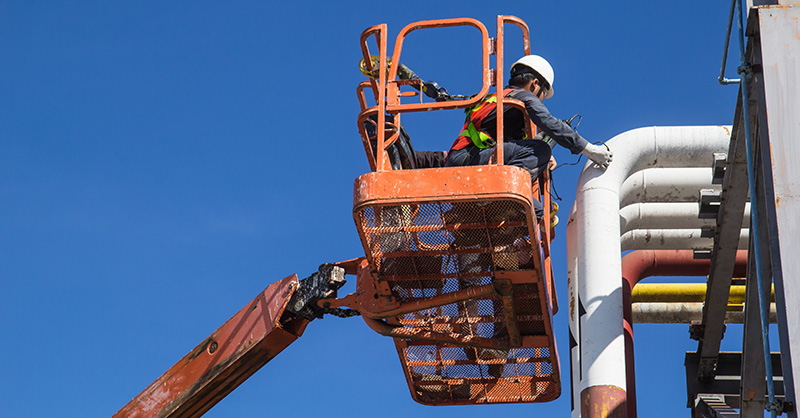Aerial Lift Safety Considerations for Your Construction Business (Checklist Included)

In 2018, the U.S. Department of Labor reported a total of 24 fatalities related to the use of aerial lifts. Of those 24 fatalities, 20 were in the Construction industry. These sobering figures underscore the importance of prioritizing safety when it comes to aerial lift operations.
What is an Aerial Lift?
According to the Federal Occupational Safety and Health Administration (OSHA), an aerial lift is defined as any vehicle-mounted device used to elevate personnel, including the following:
- Extendable boom platforms
- Aerial ladders
- Articulating (jointed) boom platforms
- Vertical towers
- Any combination of the above
Identifying Common Aerial Lift Safety Hazards
Taking the place of ladders and scaffolding, aerial lifts are commonly used on many types of construction sites. Generally, this is because aerial lifts provide a safer alternative and are more efficient when completing work at height. It is important to note that, while they can be safer than ladders and scaffolding, there are still hazards associated with using aerial lifts. Therefore, aerial lifts should only be operated in appropriate settings, according to all manufacturers’ recommended practices and safety regulations.
The following hazards, among others, can lead to personal injury or death associated with the use of aerial lifts:
- Fall from an elevated level
- Objects falling from lifts
- Tip-overs
- Ejections from the lift platform
- Structural failures (collapses)
- Electric shock (electrocutions)
- Entanglement hazards
- Contact with objects
- Contact with ceilings and other overhead objects
Recommendations for Safe Aerial Lift Operations
Ensuring safety in aerial lift operations requires a proactive approach. Here's where you can start.
Training
The first step in practicing safe jobsite aerial lift operations is to ensure that all workers are adequately trained on how to safely operate any aerial lift before they are permitted to use the aerial lift. At a minimum, training should include the following:
- Explanations of electrical, fall and falling object hazards
- Procedures for dealing with hazards
- Recognizing and avoiding unsafe conditions in the work setting
- Instructions for the correct operation of the lift (including a maximum intended load and load capacity)
- Demonstrations of the skills and knowledge needed to operate an aerial lift before operating it on the job
- When and how to perform inspections
- Manufacturer’s requirements
Employee retraining is also an important part of an effective training program because employees might not have fully comprehended the first training or might have forgotten the training. Retraining can be conducted at any time and for any reason, but an employer should generally retrain employees if any of the following conditions are observed:
- An accident occurs during aerial lift use.
- Workplace hazards involving an aerial lift are discovered.
- A different type of aerial lift is used (other than the lift employees were trained on).
Retraining should also be conducted immediately whenever employees are observed operating an aerial lift improperly.
Fall Protection
Fall protection is required on all construction sites anytime workers are 6’ or higher above any walking/working surface.
- Ensure that all access gates and/or openings are closed while the lift is in operation.
- At all times, workers should stand firmly on the floor of the bucket or lift platform.
- Workers should never climb on or lean over guardrails or handrails.
- Never use planks, ladders or other devices as a working position.
- Always use a body harness or restraining belt with a lanyard attached to the boom or bucket.
- Never “belt-off” to adjacent structures or poles while in the bucket/platform.
Traveling and Loading
It is important to fully understand and follow all manufacturer guidelines/recommendations for aerial lift operations before operating any lift. Pause operations any time you are uncertain about how to safely operate the aerial lift, and do not resume operations until they can be completed safely.
- Never exceed the rated load-capacity limits established by the lift manufacturer. The load-capacity is the combined weight of the workers, tools and materials added together.
- Never use the aerial lift as a crane.
- Never carry objects larger than the platform.
- Never drive with the lift platform raised unless the manufacturer permits this in written instructions.
- Never operate lower-level controls with workers in the lift unless there is an emergency scenario or permission is first obtained from the workers in the lift.
- Never exceed vertical or horizontal reach limits.
- Never operate an aerial lift in winds above the manufacturer’s recommended guidelines.
- Never override hydraulic, mechanical or electrical safety devices.
Overhead Protection
When an aerial lift is used to elevate workers into the air, unique hazards are presented that may not necessarily be present in work at surface levels. It is important to always consider these unique hazards both before and during lift operations.
- Always be aware of clearance to overhead objects, including ceilings.
- If possible, never position aerial lift platforms between overhead hazards.
- Treat all overhead power lines and communication cables as energized and stay at least 10 feet away.
- Ensure that the power utility or power line workers de-energize power lines in the vicinity of the work.
Work Zone Stability
Construction sites present special challenges to lift stability due to unfinished slopes and surfaces. It is important to conduct a thorough analysis of the work area to identify stability hazards before starting any work.
- Always set outriggers on pads or a level, solid surface.
- Set brakes whenever outriggers are used.
- Use wheel chocks on sloped surfaces.
- Set up work zone warnings, such as cones and signs, to warn others around the work zone.
Access Our Aerial Lift Safety Checklist
Help ensure Safe Aerial Lift Operations on your jobsite. Complete the below checklist prior to each work shift.









